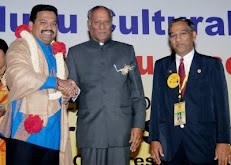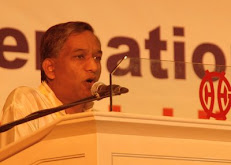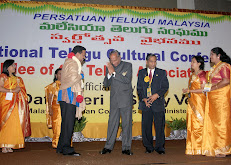Tyagaraja
| Tyāgarāja | |
|---|---|
| Background information | |
| Born | May 4, 1767 |
| Origin | Tiruvarur, Tiruvarur District,Tamil Nadu, India |
| Died | January 6, 1847 (age 79) |
| Genres | Carnatic music |
| Occupations | Carnatic Composer |
Kakarla Tyagabrahmam (Telugu: త్యాగరాజు) (May 4, 1767–January 6, 1847), colloquially known as Tyāgarājar and Tyagayya, was one of the greatest composers of Carnatic music or classical South Indian music. He, along with his contemporaries Muthuswami Dikshitar and Shyama Shastry, forms theTrinity of Carnatic music. He was a prolific composer and highly influential in the development of the South Indian classical music tradition. Tyagaraja composed thousands of devotional compositions, most of them in praise of Lord Rama — most of which remain very popular even today. Of special mention are five of his compositions called the Pancharatna Krithis (English: 'five gems'), which are often sung in programs in his honor.
Tyagaraja was born in 1767 in a Telugu Brahmin family of the Mulukanadu subsect.[1] He was named Tyagaraja, after Lord Tyagaraja, the presiding deity of the temple at Tiruvarur. Tyagaraja was born at his maternal grandfather Giriraja Kavi's house. Giriraja Kavi was a poet-composer in the court of the king ofThanjavur.[edit]
Tyagaraja began his musical training under Sri Sonthi Ramanayya, a noted music scholar, at an early age. He regarded music as a way to experience God's love. His objective while practising music was purely devotional, as opposed to focusing on the technicalities of classical music. He also showed a flair for composing music and, in his teens, composed his first song Namo Namo Raghavayya in the Desika Todi ragam and inscribed it on the walls of the house.
A few years later, Sri Sonthi Ramanayya invited Tyagaraja to perform at his house in Thanjavur. On that occasion, Tyagaraja sang Endaro Mahaanubhavulu, the fifth of the Pancharatna Krithis. Pleased with Tyagaraja's composition,Sri Sonthi Ramanayya informed the King of Thanjavur about Tyagaraja's genius. The king sent an invitation, along with many rich gifts, inviting Tyagaraja to attend the royal court. Tyagaraja, however, was not inclined towards a career at the court, and rejected the invitation outright, composing another gem of a kriti, Nidhi Chala Sukhama (English: "Does wealth bring happiness?") on this occasion.
Angered at Tyagaraja's rejection of the royal offer, his brother threw the statues of Rama Tyagaraja used in his prayers into the nearby Kaveri river. Tyagaraja, unable to bear the separation with his Lord, went on pilgrimages to all the major temples in South India and composed many songs in praise of the deities of those temples.
Tyagaraja, who was totally immersed in his devotion to Lord Rama and led the most spartan way of life without bothering in the least for the comforts of the world, did not take any steps to systematically codify his vast musical output. The late Rangaramanuja Iyengar, a leading researcher on Carnatic music, in his work Kriti Manimalai, has described the situation prevailing at the time of death of Tyagaraja. It is said that a major portion of his incomaparable musical work was lost to the world due to natural and man-made calamities. Usually Tyagaraja used to sing his compositions sitting before idols of Lord Rama, and his disciples noted down the details of his compositions in palm leaves. After his death, these palm leaves came in the possession of the disciples, and to several families descending from the disciples. Thus a definitive edition of Thyagaraja's songs did not exist.
However the popularity of his songs was widespread. Great musical experts like Kancheepuram Nayana Pillai, Simizhi Sundaram Iyer and Veenai Dhanammal saw the infinite possibilities for imaginative music inherent in the compositions of Thyagaraja and systematically notated the songs available to them. Subsequently, indefatigable researchers like K. V. Srinivasa Iyengar and Rangaramanuja Iyengar took enormous pains to contact various teachers and families who had the possession of the palm leaves. K. V. Srinivasa Iyengar brought out Adi Sangeetha Rathnavali and Adi Thyagaraja Hridhayam (in 3 volumes). Rangaramanuja Iyengar published Kriti Mani Malai in two volumes. Kriti Mani Malai is a monumental research effort.
Further, Musiri Subramania Iyer, the doyen of Bhava Sangeetham, had a vast collection of books in his library. T. K. Govinda Rao, his disciple, brought out an excellently researched volume of the songs of Tyagaraja in English and the Devanagari script. T. S. Parthasarathy, a leading scholar on Tyagaraja, published the text and meaning of Tyagaraja's songs, very popular among teachers and students alike.
There are many publications in Telugu, too, which are not as comprehensive as the works of Rangaramanuja Iyengar and T. K. Govinda Rao.
Thus, due to the painstaking labour of these musicians and researchers, there now exists a stable and definitive collection of Thyagaraja's music. Out of 24,000 thousand songs said to be composed by Tyagaraja, around 700 songs have survived.
In addition to nearly 700 compositions (kritis), Tyagaraja composed two musical plays in Telugu, the Prahalada Bhakti Vijayam and the Nauka Charitam. Prahlada Bhakti Vijayam is in five acts with 45kritis set in 28 ragas and 138 verses, in different metres in Telugu. Nauka Charitam is a shorter play in one act with 21 kritis set in 13 ragas and 43 verses. The latter is the most popular of Tyagaraja's operas, and is a creation of the composer's own imagination and has no basis in the Bhagavata Purana.
it is the fact that Tyagaraja's works are some of the best and most beautiful literary expressions in Telugu language,which every telugu person who is blessed to know the kritis agrees. Valmiki composed the Ramayana, the story of Rama, with 24,000 verses, and coincidentally Tyagaraja, too, composed 24,000 kritis in praise of the Lord.
K.V. Ramachandran, a well-known 20th-century Indian music critic, wrote: "Tyagaraja is an indefatigable interpreter of the past... but if with one eye he looks backward, with the other he looks forward as well. Like Prajapati, he creates his own media, and adores his Rama not alone with jewel-words newly fashioned, but also with jewel-[like]-music newly created. It is this facet of Thyagaraja that distinguishes him from his illustrious contemporaries." In other words, while Tyagaraja's contemporaries were primarily concerned with bringing to audiences the music of the past, Tyagaraja, apart from doing the same, also pioneered new musical concepts at the same time.
Sarvalaghu is the heart of Tyagraja's music. Tyagaraja's music is melody and rhythm personified. It is easy for children, a challenge for the learned, and a wonder for the genius.
In the publication "The Hindu speaks on music", tribute is paid to the great Carnatic music composer. "In his universality, he is like Shakespeare... Behind that magnificent achievement was a soul that had found itself. Unfashionable as it is to talk of such things, we must insist that one who would ignore the mainspring of Tyagaraja's inspiration, the mystic's love of God, can never hope to understand him or feel a fraction of his haunting charm. A sublime certitude marked the march through life of this humble man who could look with unerring insight into the heart of the peasant and the prince, the footpad and the fashionable roue. He was tempted neither by pomp and power nor by the vanity of wealth. He had antagonism for none, his heart was full of compassion. He yearned to bring to his fellowmen the peace that passeth understanding. In the company of the dedicated spirits of all time - Prahlada, Narada and Sukha - his immortal genius ministers to our need for sweetness and light."
[edit]
Tyagaraja Aradhana, the commemorative music festival is held every year at Thiruvaiyaru in the months of January to February in Tyagaraja's honour. This is a week-long festival of music where various Carnatic musicians from all over the world converge at his resting place. On the Pushya Bahula Panchami,[2] thousands of people and hundreds of Carnatic musicians sing the five Pancharatna Kritis in unison, with the accompaniment of a large bank of accompanists on veenas, violins, flutes, nagasvarams, mridangams and ghatams.
[edit]
[edit]Films on Tyagaraja (biographical)
As the most famous composer of Telugu kritis or (kirtanas), Tyagaraja, who is fondly remembered as Tyagayya, has caught the imagination of filmmakers in the Telugu film industry. Apart from references to his works, using the kirtanas as songs, two films were made on his life. The legendary Chittor V. Nagaiah made a biographical epic on Tyagaraja titled Tyagayya in 1946 which is still treated as a masterpiece of Telugu cinema. Nagayya's rendition of Endaro Mahanubhavulu and its picturisation is treated as a matchless classic even today. Later, Bapu - Ramana made Tyagayya in 1981 with J. V. Somayajulu in the lead role. Another attempt is being made by Singeetam Srinivasa Rao to picturise the life of Tyagaraja.
[edit]Compositions
The term pancharatna in Sanskrit means five gems: The Pancharatnas are known as the five finest gems of carnatic music. All the Pancharatnas are set to adi thalam. They are set in perfect sarvalaghu and contain all the musical and mathematical wonders of carnatic music. So far as Pancharathnas are concerned, fortunately a stable text has been handed over by the earlier musicians to the present day. Several musicians have brought out editions of Pancharatnas. However, Veenai Sundaram Iyer's edition is the most detailed and comprehensive. All the compositions of Tyagaraja show the way for the systematic development of the respective ragas. However, in the Pancharatnas Tyagaraja has given full, exhaustive and complete treatment as to how to systematically and scientifically develop a raga. The Pallavis and anupallavis of the Pancharatnas are absolute musical and rhythmic beauties and an earnest practice of the Pallavis and anupallavis of the Pancjaratna will reveal as to how to develop a raga in a methodical and systematic manner. The two fundamental conditions that must be satisfied for a systematic development of a raga are the arrangement of the solfa swaras in the natural order of Arohanam and Avarohanam of the Ragas so as to satisfy the sound principles of harmony and continuity. Pancharatnas satisfy these scientific principles in an unparalleled manner. The Pancharatnas are composed in perfect sarvalaghu swaras.
- The first pancharatna is Jagadanadakaraka, in the raga nATa. It is composed in the most lucid and poetic Sanskrit. It starts with praising Lord Rama who makes the entire world happy. Originally there were only six charanams for the song and when the disciples examined the song it contained ninety names of Lord Rama in mellifluous Sanskrit. The disciples requested Tyagaraja to slightly expand the song by adding two charanas containing eighteen more names of Lord Rama. The saint acceded to the request of the disciples and that is the reason why the song Jagadanadakaraka contains two mudras containing the name of Tyagaraja while the other four songs contain only one mudra each. Thus Jagadanandakaraka is a diamond garland for the Lord consisting of His 108 choicest names. The rhythmic variations of Jagadanandakaraka are amazing.
- The next is Duduku gala in the raga gowlai set to adi talam. In this song Tyagaraja takes the blame upon himself for all the misdeeds of men and ruminates as to who would come and save him from this deplorable situation.
- The third is Sadhinchene in the raga Arabhi set to adi talam. In this song Tyagaraja lovingly cricises Lord Krishna for his cleverness in getting what he wants to be done. Sadhichene is a breathtaking lullaby.
- The fourth song is in the raga varali set to adi talam. In this song Tyagaraja describes the infinite beauty of Lord Rama.
- The fifth pancharatna is Endaro Mahanubhavulu. It is said that a great musician from Kerala, Shatkala Marar visited Tygaraja and performed before him. Tyagaraja was enchanted with his performance and then was born Endaro Mahanubhavulu, the unparallelled rhythmic beauty in Carnatic music.
- From Wikipedia, the free encyclopedia



.jpg)
.jpg)
.jpg)
.jpg)
.jpg)


No comments:
Post a Comment